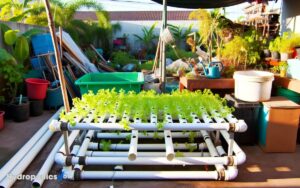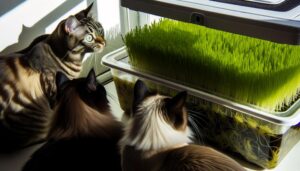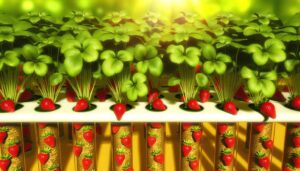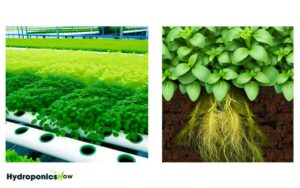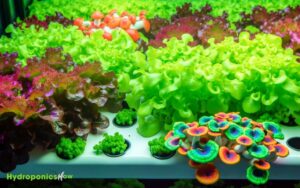Different Light Effects on Plant Growth in Hydroponics: Explore!
In hydroponics, various light spectra distinctly influence plant growth.
- Blue light activates cryptochromes and phototropins, enhancing chlorophyll synthesis and photosynthesis efficiency.
- Red light promotes flowering and biomass, regulated through phytochrome pigments.
- Green light penetrates canopies, ensuring uniform photosynthesis and influencing morphology.
Far-red light enhances electron transport, aiding photosystem I efficiency and shade avoidance. UV light stimulates secondary metabolite production but must be carefully managed.
LEDs offer customizable spectra and energy efficiency, while sunlight provides a full spectrum. Important light intensity and photoperiod management are essential for maximizing plant productivity and quality.
For a thorough understanding, explore the specific benefits of each light type.

Key Takeaways
Light Spectrum Overview
In the context of hydroponic systems, understanding the light spectrum is essential as different wavelengths of light play specific roles in plant growth and development.
Photosynthetically Active Radiation (PAR), encompassing wavelengths from 400 to 700 nanometers, is important for photosynthesis.
Blue light (400-500 nm) influences chlorophyll production, promoting vegetative growth, while green light (500-570 nm) penetrates deeper into the canopy, enhancing photosynthesis efficiency.
Far-red light (700-800 nm) affects photomorphogenic responses, such as flowering and stem elongation.
Ultraviolet (UV) light, although outside PAR, can enhance secondary metabolite production and pathogen resistance.
A precise understanding of these wavelengths allows for optimized light spectra in hydroponic systems, thereby improving plant health and yield.
Integrating spectral knowledge into lighting strategies is essential for effective hydroponic cultivation.
Red Light Benefits
Red light, spanning wavelengths from 620 to 750 nanometers, is especially important for promoting flowering and fruiting in hydroponic plants.
This specific light spectrum activates phytochrome pigments, which play a pivotal role in regulating photoperiodism a plant’s response to the length of day and night.
By enhancing red light exposure, cultivators can manipulate flowering times and improve overall yield.
In addition, red light is instrumental in driving photosynthesis by optimizing the chlorophyll absorption spectrum.
Studies indicate that red light supplementation leads to increased biomass and enhances fruit quality in various hydroponic crops.
Therefore, integrating red light in hydroponic systems is essential for maximizing growth efficiency and achieving desired horticultural outcomes.
Blue Light Effects
Blue light greatly influences photosynthesis enhancement by activating specific photoreceptors, such as cryptochromes and phototropins, which optimize light absorption efficiency.
Additionally, it regulates stem elongation and leaf morphology, contributing to compact and robust plant architecture.
Empirical studies have demonstrated that blue light exposure can result in increased chlorophyll synthesis and improved plant vigor in hydroponic systems.
Photosynthesis Enhancement
Studies have shown that exposure to blue light greatly enhances the photosynthetic efficiency of plants in hydroponic systems.
Blue light, with wavelengths ranging from 450 to 495 nm, penetrates the chloroplasts effectively, stimulating chlorophyll production.
Enhanced chlorophyll levels increase the plant’s ability to capture light energy, thereby optimizing the photosynthetic process.
Research indicates that blue light influences the opening of stomata, facilitating improved gas exchange and CO₂ uptake, critical for photosynthesis.
Additionally, blue light activates the photoreceptors cryptochromes and phototropins, which regulate the light-dependent reactions in photosynthesis.
Consequently, plants exposed to blue light exhibit higher rates of ATP and NADPH production, essential for synthesizing organic compounds through the Calvin cycle, thereby maximizing photosynthetic efficiency in hydroponic environments.
Stem and Leaf Growth
Exposure to blue light significantly influences the morphological development of stems and leaves in hydroponic plants, promoting robust growth and structural integrity.
Research indicates that blue light, particularly within the 400-500 nm wavelength range, stimulates phototropism and chlorophyll synthesis, essential processes for plant development.
Studies show that blue light induces shorter, thicker stems and enhances leaf expansion, optimizing photosynthetic capacity.
This spectral band activates photoreceptors such as cryptochromes and phototropins, which regulate cellular elongation and division, contributing to sturdy stem architecture and expansive foliage.
Controlled experiments demonstrate that hydroponic systems utilizing blue light supplementation yield plants with improved biomass and resilience, underscoring its critical role in vegetative growth phases.
Therefore, blue light is essential for effective stem and leaf development in hydroponics.
Green Light Influence
Green light, despite often being considered less effective for photosynthesis, plays an important role in the growth and development of plants in hydroponic systems.
Studies have shown that green light penetrates deeper into the plant canopy compared to red or blue light, reaching lower leaves and ensuring more uniform light distribution.
This deeper penetration can enhance photosynthetic efficiency and optimize overall plant health.
Additionally, green light influences stomatal conductance and can affect plant morphology, including leaf thickness and orientation.
Research indicates that integrating green light into the light spectrum in hydroponic setups improves biomass accumulation and enhances secondary metabolite production.
Incorporating green light into the light spectrum in hydroponic setups can contribute to more robust and resilient plant growth in controlled environments.
Far-Red Light Role
Far-red light greatly influences plant growth in hydroponic systems. It does so by modulating flowering responses, promoting stem elongation, and affecting photosynthetic efficiency.
Studies indicate that far-red wavelengths activate phytochrome-mediated pathways. This activation enhances floral induction and stem extension.
Additionally, the interplay between red and far-red light can optimize photosynthetic light capture. This optimization improves overall plant productivity.
Enhancing Flowering Response
In hydroponic systems, the application of far-red light has been shown to greatly influence the flowering response of various plant species.
Far-red light, typically ranging from 700 to 800 nm, modifies photoperiodic responses, thereby accelerating flowering in short-day plants and delaying it in long-day plants.
Studies demonstrate that supplemental far-red light enhances the expression of flowering genes, such as FT and SOC1, leading to earlier floral initiation.
| Light Spectrum | Effect on Flowering Response |
|---|---|
| Far-Red (700-800 nm) | Accelerates flowering in short-day plants |
| Red Light (660 nm) | Promotes flowering in long-day plants |
| Blue Light (450 nm) | Inhibits flowering in certain species |
| Green Light (510 nm) | Minimal effect on flowering |
Understanding these interactions allows for optimized light recipes, improving yield and quality in hydroponic flower production.
Stem Elongation Influence
The role of far-red light extends beyond flowering response, profoundly impacting stem elongation through the modulation of phytochrome activity.
Far-red light influences the balance between the active and inactive forms of phytochrome, shifting the phytochrome equilibrium towards the inactive state (Pr).
This shift reduces the inhibition of stem elongation, resulting in increased internode length and overall plant height.
Empirical studies in controlled hydroponic environments have demonstrated that supplemental far-red light can greatly enhance stem elongation in various plant species.
This effect is particularly pronounced in shading conditions, where far-red light is more prevalent.
Understanding the mechanistic pathways of far-red light in stem elongation provides critical insights for optimizing growth conditions in hydroponic systems, aiming for specific morphological traits.
Photosynthetic Efficiency Impact
Frequently overlooked, the role of far-red light in enhancing photosynthetic efficiency is mediated through its interaction with photosystem I, potentially improving overall plant growth and productivity in hydroponic systems.
Far-red light, with wavelengths between 700-750 nm, extends the light absorption spectrum, facilitating enhanced electron transport rates. This can lead to increased photosynthetic performance and biomass accumulation.
Research indicates that incorporating far-red light can optimize light use efficiency by:
- Activating photosystem I for improved electron transport.
- Enhancing shade avoidance responses, leading to better light capture.
- Modulating phytochrome signaling, which influences growth and developmental processes.
- Improving chloroplast function and overall photosynthetic capacity.
Employing far-red light strategically in hydroponic setups can therefore yield significant agronomic benefits.
UV Light Impact
Ultraviolet (UV) light exerts significant influence on plant morphology and physiology in hydroponic systems.
UV radiation can enhance secondary metabolite production, including flavonoids and anthocyanins, which contribute to plant defense mechanisms and stress tolerance.
However, excessive UV exposure may lead to detrimental effects such as DNA damage, impaired photosynthesis, and reduced growth rates.
Studies indicate that controlled UV-B exposure can stimulate photomorphogenic responses, improving plant structure and resilience.
For instance, UV light can induce thicker leaf cuticles and increased trichome density, potentially reducing pest infestation.
Additionally, UV-C has been employed as a sterilization method to mitigate microbial contamination in hydroponic setups.
Therefore, judicious application of UV light can optimize plant health and productivity within hydroponic environments.
LED Vs. Sunlight
Comparing LED lighting to natural sunlight reveals nuanced differences in spectral quality, intensity, and photoperiod control that have a substantial impact on plant growth outcomes in hydroponic systems.
LED lights provide a customizable spectrum, enabling precise delivery of wavelengths best suited for photosynthesis and growth stages. Sunlight, however, offers a full spectrum inherently suited to plant needs but lacks controllability.
Key considerations include:
- Spectral Quality: LEDs can be fine-tuned to emit specific wavelengths, enhancing photosynthetic efficiency.
- Intensity Control: LEDs allow for adjustable light intensity, important for different growth phases.
- Photoperiod Management: LEDs facilitate precise control over light duration, optimizing growth cycles.
- Energy Efficiency: LED systems are more energy-efficient compared to the broad-spectrum nature of sunlight.
These factors underscore the critical differences between LED and sunlight in hydroponics.
Light Intensity Matters
Ideal light intensity is crucial for maximizing photosynthetic efficiency and promoting robust plant growth in hydroponic systems.
Light intensity is measured in micromoles of photons per square meter per second (µmol/m²/s), and its optimization varies with plant species and growth stages.
Elevated light intensity enhances chlorophyll production, thereby boosting photosynthesis and biomass accumulation.
However, excessive light can lead to photoinhibition, damaging plant tissues, and reducing growth rates.
| Light Intensity (µmol/m²/s) | Plant Response |
|---|---|
| 100-200 | Seedling establishment |
| 300-500 | Vegetative growth |
| 600-800 | Flowering and fruiting |
| >1000 | Risk of photoinhibition |
Balancing light intensity to meet plant-specific needs is crucial for achieving the best growth outcomes in hydroponic environments.
Photoperiod Considerations
Understanding the best photoperiod is essential for regulating plant growth cycles and maximizing yield in hydroponic systems.
Photoperiod, the duration of light exposure plants receive, greatly influences physiological processes such as photosynthesis, flowering, and vegetative growth. Research indicates that manipulating photoperiod can optimize plant productivity.
Key considerations include:
- Photoperiod sensitivity: Different species require specific light-dark cycles for the best growth.
- Long-day plants: These plants flower when daylight exceeds a critical duration, often over 14 hours.
- Short-day plants: These plants require longer nights to initiate flowering, typically needing less than 12 hours of light.
- Day-neutral plants: These species are indifferent to photoperiod and rely on other environmental cues.
Carefully tailored photoperiods can significantly enhance crop quality and yield in hydroponic systems.
Conclusion
In hydroponic systems, the influence of light on plant growth is nothing short of transformative. Red light is an indispensable powerhouse, blue light is a veritable necessity, and green light, often underestimated, plays a subtle yet critical role. Research in hydroponics and plant science has shown that red light promotes flowering and fruiting, while blue light is essential for vegetative growth and strong root development. Meanwhile, green light, though less efficient in photosynthesis, penetrates deeper into the plant canopy, ensuring uniform growth in dense hydroponic setups. The careful balance of these light spectra is crucial for optimizing yields and maintaining plant health in controlled environments.
Far-red light is a game-changer, while UV light exerts profound impacts. LED lighting, with its unparalleled precision, outshines sunlight. Intensity and photoperiod considerations are paramount, underscoring the intricate interplay of these factors in optimizing plant development.

